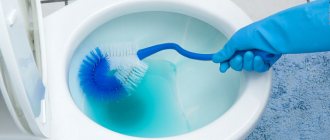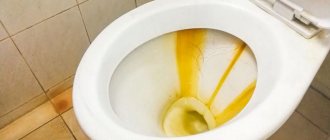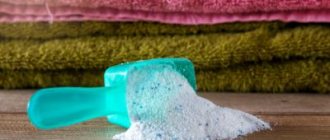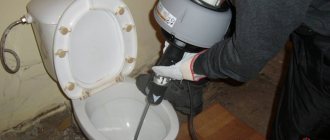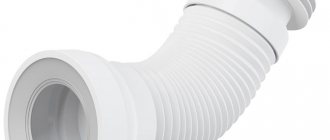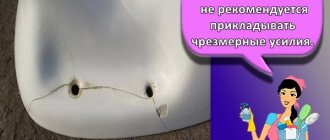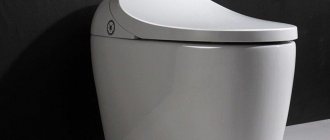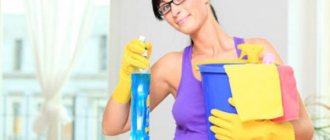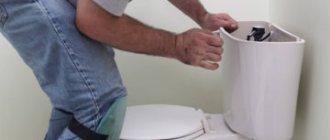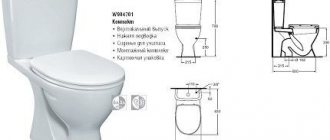Clean plumbing is an indicator that it is regularly maintained. The toilet is used frequently, so a variety of contaminants accumulate in it. If small deposits are not removed in a timely manner, they will harden and will not be so easy to get rid of. The main problems encountered when cleaning a toilet are limescale and urinary stone.
Causes of toilet contamination
Limescale is also sometimes called waterstone; it is formed as a result of the deposition of salts contained in tap water.
As a rule, the yellowish coating is located precisely in the areas where the water is flushed, but sometimes it can be seen under the rim of the toilet bowl and on the lid. Without proper care of your plumbing, the limescale layer gradually builds up, making it difficult to remove. In addition to the toilet, you should periodically clean the bathtub and shower stall to remove this deposit.
Cleaning the toilet takes a couple of minutes a day
Urinary stones are made up of mineral components that are found in human urine. Deposits begin to form when residents regularly forget to flush the toilet. Another problem is rust - rusty stains also form in places where water is flushed.
In addition, other reasons for the appearance of deposits in the toilet can be noted:
- high concentration of salts in water;
- the presence of cracks and other damage on the walls of plumbing fixtures;
- faulty barrel.
Attention! Despite the fact that water and organic stones spoil the appearance of plumbing fixtures, deposits are an excellent breeding ground for microorganisms.
You can cope with this problem at home using available means. In difficult cases, when there is too much contamination, you will have to use chemicals.
To wash plumbing fixtures, you need to purchase thick gloves.
How to remove lime deposits in the toilet using specialized means
Sometimes household products for dealing with solid deposits may not be at hand. In addition, not everyone is ready to carefully measure the proportions of soda or vinegar for cleaning. In this case, you can purchase one of the specialized products - they show good effectiveness and help to easily remove stone deposits.
In general, chemicals for plumbing can be divided into several categories:
- Acidic. These include Toilet Duckling, Sanox and other gels with a rather aggressive composition. They help best against old limescale deposits, but you need to work with them very carefully, protecting your face and hands. Acid gels should not be left on the enamel for too long, as they can damage the surface.
- Alkaline. This category includes Domestos, Bref, Dosya - alkaline products pose less danger to humans and plumbing than acidic ones, but their effectiveness is slightly lower. Alkaline gels work best to remove fresh plaque that has not yet had time to properly adhere to the surface.
- Chlorine-containing. Products with a high percentage of chlorine in their composition, for example, Comet or Titan, are suitable for regular and preventative cleaning. They cope well with plaque, but leave behind an unpleasant odor. The restroom should be thoroughly ventilated after cleaning, and when cleaning, use a mask to avoid inhaling chlorine fumes.
It is better to clean plumbing fixtures with gel products rather than abrasive powders
Attention! Many of the listed products are presented in stores in the form of not only gels, but also powders. But for cleaning it is better to use liquid substances; abrasive powders scratch the surface of plumbing fixtures and, as a result, contribute to the appearance of new plaque.
General rules for cleaning plumbing fixtures
Before you start washing your plumbing, you must do the following:
- Put gloves on your hands and cover your nose with a special mask. Any plumbing cleaning products dry out the skin and can release dangerous fumes that burn the respiratory tract.
- All water should be pumped out of the toilet. This can be done with any device - for example, a ladle, and wipe off any remaining moisture with a rag. This is done in order to increase the effectiveness of cleaning products.
It's comfortable! Instead of a ladle, it is recommended to use a special syringe for pumping out automobile oil. This device is often used by plumbers before repairing a toilet.
A syringe can be used to quickly and hygienically pump water out of the toilet.
How to clean plaque with bleach?
The most common and accessible product containing chlorine is “Whiteness”. But in addition to its whitening and cleansing properties, this liquid is also famous for its disinfecting effect. Thanks to this, you can not easily clean your sanitaryware, but also simultaneously remove various microbes, bacteria and E. coli. But there are also disadvantages to this drug: as scientists have proven, chlorine has a negative effect on the functioning of the female body. If this fact is not an obstacle to achieving a truly clean home toilet, then it is recommended:
- Scoop out all the water from the toilet and dry all the walls of its internal cavity.
- Spray white on all problem areas inside the toilet without touching the rim.
- Then you should close the lid and leave the white to dissolve all lime deposits for 45–50 minutes.
- After this, you should wash all problem areas using a brush and rinse off the dirt 2-3 times with clean water.
What tools should I use to clean the toilet?
The following household appliances are usually used for cleaning plumbing:
- brush;
- a special sponge with a long handle;
- a cloth made of natural textiles.
When choosing a brush, it is necessary to take into account that it should not be too hard or iron, otherwise the surface of the walls of the toilet bowl will quickly be scratched and become unusable. Using a long-handled sponge, apply detergents to stones and plaque. Upon completion of the procedure, you must thoroughly wipe the walls with a cloth.
Sponge on an extended handle
Please note that when using any cleaning products, you must carefully study their composition and instructions. In addition, it is better not to use them at the same time - otherwise an unpredictable chemical reaction may occur.
In addition, you should not keep any product (even those based on natural ingredients) for longer than the prescribed time, because some substances contribute to the destruction of the toilet bowl coating.
Acid solutions of different concentrations
Folk remedies are suitable if the dirt has not accumulated for years. To remove thick plaque, the old technique uses strong acids.
Oxalic acid
Oxalic acid is considered a technical agent that is used in preparing surfaces before applying enamel. The powder is used dry or diluted with water. The prepared mixture cleans the toilet from both urinary stone and rust. The product is toxic, so you cannot work with it without a respirator and hand protection.
Phosphoric acid
A component of Coca-Cola, orthophosphoric acid, can be used in apartments with plastic pipes: its action will not disrupt the operation of the sewer system. But it will cope with rust removal successfully. Exposure time is 15-20 minutes. Operating procedure:
- 100g of the substance is placed in a tank;
- 100g is poured into the toilet;
- After 15 minutes, treat the inner walls with a brush;
- Wash off the solution;
- Refill the reservoir and rinse.
Hydrochloric acid
Unlike the previous option, hydrochloric acid is not suitable for plastic pipes; the solution will damage the system.
200 g of the substance is placed in a container and the mixture is smeared inside with a brush. The toilet lid is closed after the procedure. The exposure period of the base is about 10-15 minutes. You need to rinse off the component well and ventilate the room.
Removing thin and medium plaque
If the layer of plaque and urinary stones is not too thick, then you can get by with the help of folk remedies and gentle alkaline remedies.
Using soda and vinegar: step-by-step instructions
This is a powerful remedy that effectively dissolves stones of even medium thickness.
Step one: First you need to pour vinegar into a container and then heat it to a temperature of 38-39 degrees.
The vinegar must be hot
Step two: now you need to add soda (about 5-8 grams) to the hot vinegar.
Baking soda and vinegar will react
Step three: now this mixture must be poured into the toilet so that the stones and limescale are saturated. The composition must be left for 6-7 hours.
Paper napkins soaked in the solution should be placed in hard-to-reach places.
Step four: after a while, remove any remaining deposits using a brush.
Use a small brush to clean the toilet in hard-to-reach places
Step five: upon completion of the reading, you need to flush the toilet with water from the barrel.
There should be no deposits left on the surface
Video - How to clean a toilet without chemicals
Using citric acid: step-by-step instructions
This method can dissolve a thin layer of urinary stone or limescale. In addition, in this case there is no need to remove water from the toilet in advance.
Step one: first you need to pour 75 grams of citric acid into the toilet, then leave it for a couple of hours.
It is necessary to ensure that the powder covers all contaminants.
Step two: after the allotted time, you need to take a brush and forcefully wipe off all the dirt.
At the end of the procedure, the toilet must be rinsed with hot water.
Bleach against limescale: step-by-step instructions
In this case, it is necessary to use any product containing chlorine, including “Whiteness”. This method will not only cope with contamination, but will also eliminate pathogens.
Step one: first you need to pour all the bleach into the toilet. It is advisable to leave this remedy for 12 hours, so it is recommended to carry out the procedure at night.
It is necessary to close the toilet with a lid
Step two: in the morning you need to rinse the toilet with hot water.
If some dirt remains, you can clean it with a brush.
Using technical soda and baking soda: step-by-step instructions
This method will also help remove minor dirt from the surface of the plumbing fixtures.
Step one: first you need to mix baking soda and technical soda in one container.
Step two: then add water to get a porridge-like consistency.
This is what a stain treatment product should look like
Step three: now this product must be applied to toilet paper and applied pointwise to all stains. It is advisable to leave the toilet like this overnight.
In the morning you just need to wash off the product
Using a carbonated drink: step-by-step instructions
Carbonated drinks not only help dissolve yellow limescale, but also quickly remove rust.
How soda works on rust
Step one: you need to take a 2-liter bottle of Coca-Cola (or another) drink, and then pour the contents into the toilet.
The toilet should be left in this form for 8-9 hours.
Step two: when the soda dissolves all traces of plaque, you will need to thoroughly rinse the toilet with water and then clean it with a brush.
To enhance the effect, you can treat the plumbing with soda
Video - Cleaning the toilet with soda
Cleaning the toilet with folk remedies
If it is not possible to use store-bought household chemicals, they can be replaced with improvised products. According to reviews from housewives, popular councils bleach and disinfect the toilet no less effectively. Let's look at the most popular ones.
Alkali
Recently, housewives have begun to actively use caustic soda. Alkali is the best tool for cleaning the toilet from urinary stone and grease. Before you start cleaning the toilet, be sure to wear thick rubber gloves.
Algorithm for cleaning a toilet using alkali:
- Remove any liquid from the toilet bowl completely. If you do not have a special device, simply scoop out the water.
- Pour the diluted lye into the container, cover with a lid for 3-4 hours.
- Treat contaminated areas with a brush.
- Rinse with water several times to remove any remaining lye and dirt.
Lemon acid
This product removes any impurities, including urinary stones. To clean the toilet, three tablespoons of the substance is enough.
Algorithm for using citric acid:
- Pour the entire dose of acid into the toilet.
- Cover with a lid for 4 hours.
- After this time, open the lid and flush the toilet with water several times.
- If there are small dirty areas left, scrub them a little with a brush.
If the dirt is deeply ingrained into the surface, repeat the procedure with acid several times in a row. To protect your plumbing from contamination, use this effective product once a month.
Vinegar
According to some consumers, the best remedy for keeping the toilet clean is a vinegar mixture. The essence is prepared according to the following recipe:
- Add a teaspoon of iodine to 200 ml of vinegar and heat to 50 degrees. It is better to cover the container with vinegar with a lid so that a strong smell does not spread throughout the room;
- Pour the heated solution into the toilet bowl, previously cleaned with baking soda;
- Cover the toilet with a lid for 10-12 hours.
After the specified time has passed, rinse the bathroom with copious amounts of water, while simultaneously wiping it with a toilet brush or soft brush.
Bleaching
The best way to clean a toilet from stone and bacteria is regular bleach. This substance has a high whitening effect, but in order for it to overcome urinary stones, you need to work a little more on the problem areas with a brush or a special pumice stone on a stick.
Household chemicals
There are various household chemicals that effectively cope even with old stains. They contain an active substance - alkali, due to which they effectively break down organic and other mineral deposits. In addition, they allow you to disinfect the surface from pathogenic microorganisms.
Powders
These are effective means for cleaning the toilet from various contaminants, but their main disadvantage is the presence of abrasive particles that scratch the glossy surface of the plumbing fixtures. This problem leads to the fact that every year the condition of the toilet worsens and it becomes dirty faster, so you need to use powders as little as possible. For example, with their help, general cleaning of plumbing is carried out, and then cleanliness is maintained using more gentle means.
Table 1. List of popular powder products
| Title, illustration | Description |
| "Comet" | This is a universal cleaning powder that is suitable not only for plumbing fixtures, but also for tiles. It must be applied to a damp surface in an amount of 10-15 grams, after which the surface should be thoroughly rubbed with a brush. The maximum exposure time of the product is 8-10 minutes. |
| "Pemolux" | This powder contains soda and small marble chips, thanks to which it copes even with old stains. It is necessary to apply the optimal amount of powder to the surface, and then rub thoroughly, applying force. |
| "Chistin" | This product is intended for washing dishes, countertops, kitchen furniture and bathroom fixtures. It quickly dissolves urinary stones, plaque, and also removes unpleasant odor. According to the instructions, it should also be applied for no more than 10 minutes, and then rinse the toilet thoroughly with water. |
| "Biolan" | This is one of the most gentle powders for cleaning any surfaces, including the toilet. It consists of small abrasive particles that do not scratch the coating even with intense impact. According to the manufacturer's recommendation, leave the powder on the dirt for up to 8 minutes, then rinse with water. If there are old contaminants, the holding time can be increased. |
Prices for popular cleaning products for tiles, plumbing and pipes
Cleaning products for tiles, plumbing and pipes
Liquids
Such products should be left on traces of limescale for a few minutes and then washed off. There are many liquids for cleaning toilets, as a rule, in stores they are on the same shelf - you can compare several products.
One of the most effective cleaning products is Sanox. It is used both for cleaning plumbing fixtures and for clearing blockages in pipes. It quickly removes traces of limescale, rust, stones and fights staphylococcus.
The total exposure time of this product does not exceed 7 minutes. After which it is recommended to rinse the surface several times with running water.
Liquid cleaner "Sanox"
Gels
These are the most convenient products that are suitable for cleaning any dirt. The gels have a thick consistency, making them easy to apply to the walls of the toilet bowl or under the rim. On average, the exposure time of such substances is 25 minutes, after which you will need to thoroughly scrub the toilet with a brush and rinse with water.
Table 2. List of popular gels
| Title, illustration | Description |
| "Toilet duckling" | This gel contains hydrochloric acid (15%), thanks to which it copes with almost all types of bacteria and contaminants. Another advantage of the product is its convenient neck, which makes it possible to use it in hard-to-reach places. The gel does not act immediately, it must be left for about 35 minutes to effectively soften all stones and plaque. |
| "Domestos" | The main purpose of this gel is to disinfect surfaces, because it contains sodium hypochlorite. In addition, it helps eliminate strong odors. This gel must be applied liberally to the surface of the plumbing fixtures. Despite the fact that the manufacturer recommends leaving the product on for about 30 minutes, for severe stains it should be left overnight. In the morning, you only need to rinse the toilet to remove any remaining gel and plaque. |
Cleaning creams
They have a similar effect to liquid products or gels, but have a denser consistency. They should only be applied to contaminated areas, which can then be covered with toilet paper. Since creams contain gentle ingredients, they can be left on the plumbing for several hours.
The most effective of them is the Sif cleaning cream. It is enough to apply it to the surface in a minimal amount and leave for 40-45 minutes. Contaminants will be removed even without additional exposure, so it will be enough to flush the toilet with water.
Cleaning cream "Sif"
Tablets for the tank
These tablets are used to prevent the formation of water and urinary stones, because they help soften the water, and therefore are installed in the tank. Each time you rinse, you will see brightly colored water (usually green, blue or cyan), and if it becomes clear, you should replace the tablet. Another advantage of such devices is their pleasant aroma.
Using tablets will keep your toilet smelling pleasantly clean.
Preventing the formation of contaminants
Once you try to remove traces of old plaque or rust using one of the above methods, you will come to the conclusion that it is better to prevent than to make such efforts.
Especially when you consider that preventive measures are quite simple and require much less time and effort.
- To prevent the formation of limescale, use special tablets for the tank . Their main action is aimed primarily at softening water and neutralizing alkalis. They also tint the water in various shades and give it a pleasant aroma;
- Gel products, which are attached to the rim of the toilet, disinfect the surface with each flush and prevent the formation of urinary stones;
- Make sure that the toilet tank does not leak , otherwise the formation of rust is inevitable;
- If the tank is functioning normally, but rust still forms, it is necessary to replace the old water pipes , otherwise the problem will not go away. If the pipes in the apartment are plastic, it means that corrosion has affected the iron pipes of the central water supply. In this case, only installing a filter will help;
- Once a week, treat the surface of the toilet with chlorine-containing products or regular white. This is both a method of disinfection and elimination of unpleasant odors, and a way to combat the appearance of limescale;
- If the design allows, once a week remove the lid and toilet seat and wash them thoroughly with any detergent and then under hot water;
- Make sure that all family members use the drain , otherwise your efforts will be in vain.
The article was written for the site.
Tags:Cleaning, Toilet
How to remove a thick layer of plaque and urinary stones?
If traditional methods and gentle alkaline remedies do not help to cope with deposits, then strong acids will come to the rescue. Of course, experts strongly recommend against using such products on an ongoing basis, as they destroy the coating of the plumbing fixtures.
Table 3. List of potent acids
| Title, illustration | Title, illustration |
| Oxalic acid | It is an acid of organic origin with moderate toxicity. This product was used to clean plumbing fixtures several decades ago. It quickly breaks down deposits on the walls of the toilet. You can purchase it at any store where building materials are available. Before use, you should carefully read the instructions and wear silicone gloves. Application: 1. Dissolve a small amount of acid in water. 2. Pour into the toilet and leave for 60-70 minutes. 3. Rinse several times with clean water. If there are old stains, you can apply dry acid to a wet rag and apply it to the area. |
| Orthophosphoric acid | This acid is of chemical origin, it quickly copes with organic mineral formations and rust. However, its main property is that the acid does not destroy plastic pipes. Application: 1. Pour 90 ml of acid into the tank and the toilet itself. 2. Wait about 20 minutes. 3. Rinse off the product under high water pressure and wipe the surface with a brush. |
| Hydrochloric acid | This is a product based on toxic components that dissolves any contaminants in a matter of minutes. However, it should be used carefully, otherwise it can cause harm to health - the acid fumes burn the respiratory tract. Application: 1. Apply acid evenly to dirt. 2. Wait 15 minutes. 3. Rinse the toilet with plenty of water. This cleaning method is absolutely not suitable for owners of plastic pipes. |
| Electrolyte | Battery electrolyte contains a caustic component - sulfuric acid, which quickly breaks down mineral deposits. You can find this product at an auto parts store. The electrolyte should be used by analogy with hydrochloric acid. It is recommended to keep it for about 10-12 minutes and then rinse with water. |
Rust removers
There are many ready-made household chemicals designed to remove traces of rust.
You already know about them from advertising.
Let's talk about folk remedies:
- No. 10. Solutions of various acids, work well against yellow marks . It is necessary to take 100 g of a solution with a concentration of no more than 5-7% and distribute it evenly over the surface of the toilet and leave half for pouring into the flush tank itself. After 10-15 minutes, no more, you need to rinse and go over the bowl with a ruff or a brush with stiff bristles;
- № 11. Another effective remedy is sodium dioxide.
You will need 1 tbsp. baking soda and 200 ml vinegar . The vinegar must be slightly heated; under no circumstances bring the liquid to a boil. Dissolve baking soda in vinegar and wipe off any traces of rust with the resulting solution. Don't wash it off right away. Leave the product on the surface for several hours. Then re-moisten the sponge in the solution, wipe off the dirt and rinse with water; - No. 12. Oxalic acid. It is usually sold dry and appears as transparent crystals. You need to pour a little acid onto a cloth or sponge, lightly moisten it with water or alcohol and wipe the surface thoroughly. After this, wait 10-15 minutes, go over the problem areas with a sponge again and thoroughly rinse the toilet with clean water;
- No. 13. If traces of rust have just begun to appear, you can try to remove them using regular washing powder. The surface of the toilet bowl should be evenly sprinkled with any powder and left to act for 30 min-1 hour. After this, thoroughly scrub the surface with a brush and rinse with water. For an additional effect, you can flush the toilet with Domestos or any other similar product. If yellowish streaks are still visible, pour regular White over them and leave to sit for 30 minutes. Wipe thoroughly again with a brush and rinse with water. The marks should disappear.
To combat rust, methods using Coca-Cola, hydrochloric acid or electrolyte are also suitable.
How to care for toilets made of different materials?
Each material has individual properties, so you need to familiarize yourself with them:
- Porcelain. Structures made from such material quickly deteriorate when using powders with abrasive particles, because they scratch a smooth surface. Use gels!
- Faience. It is not recommended to clean plumbing fixtures made of such material with hard brushes and wash with hot water, otherwise the possibility of cracks may occur.
- Polymer concrete. It is recommended to clean such toilets only with liquid substances and gels.
- Stainless steel. These are durable products that are not destroyed by aggressive alkali and boiling water, so there are no restrictions on their washing.
Earthenware sanitary ware
Prices for toilets, urinals, bidets
Toilets, urinals, bidets
Preventing the appearance of limescale in the toilet
The easiest way to protect your plumbing from the appearance of lime deposits is through timely prevention. To keep your toilet clean and fresh, we recommend:
- clean the inside of the plumbing fixture with household or industrial chemicals weekly, it takes little time, and limescale does not form on the walls of the bowl;
- use a brush after each trip to the toilet for emergency cleaning of the walls;
- repair the drain tank in a timely manner if water is leaking in it; liquid constantly flowing along the walls of the earthenware bowl accelerates the appearance of plaque;
- use special cassettes and tablets that soften and purify water; they are designed not only to aromatize the restroom, but also to protect plumbing fixtures from lime deposits;
- clean plumbing fixtures only with a special brush, sponge or soft brushes without using hard abrasive tools - a scratched earthenware surface will become covered with plaque faster.
It is not recommended to pour the remains of fatty and hot food down the drain - this creates a thin film on the walls of the plumbing, which contributes to the appearance of plaque. If plumbing is still used to dispose of food waste, then each time it must be immediately cleaned with a brush and flushed twice.
Regular prevention prevents deposits from appearing on the walls of plumbing fixtures
How to prevent the formation of plaque and urinary stones?
In order to keep your plumbing fixtures tidy, you must adhere to the following recommendations:
- At least once every 7 days, thoroughly clean the plumbing using household chemicals. The frequency of cleaning can be increased or decreased, depending on the number of residents in the apartment.
- It is necessary to monitor the serviceability of the tank. If it starts to leak, you need to make repairs or purchase a new one.
- The drain tank should be constantly filled with gentle detergents to prevent deposits.
- It is strictly forbidden to flush fat down the toilet after cooking.
As you can see, the rules for caring for plumbing are not complicated, but following them will prevent unpleasant problems.
Home Remedies Review
Regular home care helps prevent plaque buildup, but if trouble occurs, use the following products and formulations:
- Oxalic acid. Quickly copes with complex tasks - dissolves water stone in the toilet. The instructions warn about the pronounced caustic nature of the substance; you can work with it wearing thick gloves, a respirator and safety glasses.
- White. The liquid product acts as an alternative to chlorine. Use for cleaning the toilet. It lasts for several hours, after which the bottom and walls shine.
- Lemon acid. A gentle method for difficult stains. Removes plaque of various densities, cleans the cement joint between tiles from blackness. It will also help to refresh a teapot with deposits on the spirals and walls.
- Vinegar. Table acid dissolves contaminants and kills dangerous pests. If the washing machine is covered with lime, pour it into the compartment instead of powder and turn it on to the normal washing program.
Removing limescale using home remedies is safe for your surfaces and your family's health.
Let's sum it up
When choosing a toilet care composition, it is necessary to take into account not only the material of the plumbing fixtures, but also the pipes - for example, plastic pipes “will not forgive” the use of aggressive acids. In addition, you should not wash the structure too often with chemical components, if you can get by with traditional ones - this way you will preserve the glossy surface for a long time.
Finishing the toilet with PVC panels will greatly simplify the improvement of the interior of the toilet. In a special article, we’ll look at how to finish wall panels in a bathroom, and we’ll also figure out how to choose the right material.
Traditional methods for removing pollution
Citric acid and vinegar are great not only for cleaning the toilet, but also the bathtub.
Quite often, not household chemicals, but traditional methods are used to clean the toilet. Below are the means that are considered the most effective.
Lemon acid
To prepare the cleansing mixture you will need:
- 2 sachets of citric acid;
- brush or brush;
- gloves.
Sequencing:
- Scoop water out of the toilet bowl.
- Pour the contents of the sachets over the entire surface, not forgetting hard-to-reach places (for example, under the rim).
- Lower the lid and leave for 3-4 hours. The citric acid should be absorbed into the dirt.
- Using a brush or a brush, thoroughly wash the toilet bowl from plaque and urinary stone.
If necessary, the procedure can be repeated.
Citric acid and vinegar
To prepare the cleanser you will need:
- 2–3 sachets of citric acid;
- ½ cup 9% vinegar;
- brush or brush;
- spray;
- gloves.
The algorithm of actions is as follows:
Scooping water out of the toilet. Citric acid is poured over the entire surface of the bowl. Close the toilet lid and let it sit for 3-4 hours. Use a spray bottle to spray vinegar in areas of heavy dirt, directly on top of the citric acid.
As a result, a chemical reaction begins. After a few minutes, when the mixture stops hissing and bubbling, carefully clean it off along with the plaque using a brush or brush. Residues are washed off with warm water.
Soda
To prepare the cleanser you will need:
- baking soda and soda ash;
- brush;
- gloves.
The cleaning process is as follows:
- Baking soda and soda ash in a 1:1 ratio are poured into the toilet.
- Lower the lid and leave overnight.
- In the morning, remove dirt with a brush.
Professional products
It is recommended to use gel products more often, as abrasives can cause cracks in the toilet.
There are now many cleaning products on the household chemicals market that do an excellent job of removing limescale or rust.
These include:
- Cillit Bang;
- Domestos;
- "Toilet duckling";
- "Sanox";
- Sanfor.
Recommendations for the use of each of the listed products can be found on the packaging.
We are looking for the reason for the appearance
To skillfully solve a problem, it is worth familiarizing yourself with its root causes. What is limescale? These are deposits of minerals contained in the water you use to flush the toilet. These minerals are present in both river water and well water. Thus, the more often the water is flushed, the more the existing problem worsens.
You can not only remove old plaque with your own hands, but also prevent its appearance. In particularly advanced cases, plaque can cause clogging of the hole (or holes) from which water is supplied to clean the interior of the toilet.
A urine stone is a phenomenon that indicates the laziness of the owners, who forget to flush the toilet after themselves after relieving themselves. Drops of urine dry on the walls and lead to the appearance of very unsightly stains, and subsequently to the appearance of urinary stones. It is possible to clean them, but it is much better to prevent them by promptly carrying out sanitary cleaning and cleaning of plumbing fixtures.
Where does mineral formation come from?
Essentially, this is a mineral deposit that forms on the walls of the toilet, under the rim and where water stagnates due to drops of urine falling on the surface. The growth of urinary stones occurs because
- after using the toilet, not everyone remembers to flush (this problem is especially relevant for families with small children - children often forget to flush after themselves);
- a leaking tank promotes the spread of mineral deposits;
- defective plumbing fixtures, for example, with an uneven, textured surface, provoke the accumulation of microbes, dirt and plaque;
- The toilet is too old and therefore susceptible to all kinds of damage.
Such a stone is not only an aesthetic problem. The fact is that if the growth is not dealt with, it can grow to the point that the opening of the toilet and sewer pipes narrows. That is why you need to start fighting the stone immediately.
Adviсe
A few life hacks from experienced housekeepers will help you keep your toilet plumbing clean. By adjusting the flow in the tank, you can reduce the accumulation of urinary stones in the toilet.
Chemical cleaning products have a strong, unpleasant odor . It is better to close the toilet lid while treating urinary stones. Otherwise, strong odors can cause headaches.
Thick, ingrained yellow deposits will remove battery electrolyte. Having protected your hands with gloves, your eyes with safety glasses, and your respiratory tract with a respirator, the walls of the toilet bowl are filled with electrolyte. In just five minutes, your plumbing will shine like new.
All the most important and useful information on cleaning the toilet is presented in this section.
What measures to take in advanced cases
If the toilet is already quite old, then roughness, chips and cracks can be found on its surface. In such cases, even regular cleaning with powerful products will not help avoid the appearance of deposits. Most often, only replacing the toilet helps, but if this is not yet possible, you can resort to unconventional methods to remove urinary stones in the toilet:
- "Coca Cola";
- electrolyte (battery fluid).
To wash the stone, you will need 1 liter. carbonated drink. It is poured into the toilet and left for 2 hours. “Coca-Cola” will corrode the deposits, and they will be easily removed from the surface; all that remains is to lightly rub with a brush and rinse everything off with water.
If all of the above methods do not help, then you can use an electrolyte.
The electrolyte quickly corrodes not only urinary stones, but also sewer lines. If the sewer pipes are made of iron, then this method can be used.
Using electrolyte requires special care and precision. It can easily clean the toilet from stone, but it can also leave burns on the body
Therefore, before starting work you need to take care of your uniform. The person must wear a rubber apron, gloves, and a respirator. You also need to protect your eyes with glasses and only then take the acid.
You need to pour the electrolyte carefully and slowly so that it does not splash. To do this, you need to hold the container so that it is as close to the toilet as possible.
After the liquid has been applied to all the necessary areas, you need to wait 15 minutes, then simply wash off the electrolyte, and along with it the urinary stone. There is no need to skimp on water; you should rinse it off at least 6 times.
Regardless of what means a person uses, he must always take care of his safety.
We are taking tough measures
Complex stains are removed using concentrated acids. When working with chemicals at home, use rubber gloves, a protective gown or plastic apron, and a respirator. Do not close the doors to the toilet, and after treatment, thoroughly rinse the toilet and thoroughly ventilate the room as a whole.
Dry oxalic acid. Technical acid is sold in powder form. It is applied to a piece of cloth and the dirt is rubbed off manually.
When washing the toilet this way, you need to take precautions.
Electrolyte for acid batteries. This substance allows you to get rid of difficult-to-remove plaque
Contains concentrated acid. Cannot be used if sewer pipes are made of plastic. Pour it into the toilet, and after half an hour or an hour, wash it off with water.
Hydrochloric acid. Sold in plumbing stores, usually used for cleaning water heaters in gas boilers, water heaters, etc. The principle is the same as with electrolyte. With its help you can get rid of all types of stone.
Iodine monochloride. Liquid product, you can buy it in veterinary pharmacies. Perfectly removes all types of stone. The solution is poured over the contaminated areas and almost immediately washed off with water - the product eats away lime deposits and rust within a few minutes. Cannot be used in homes where sewer pipes are made of cast iron. Iodine monochloride is also aggressive to aluminum.
And finally, we note that it is undesirable to use potent products too often - they spoil the surface of the plumbing fixtures, leaving microdamages on it. After washing off the limescale and stone once, sanitize the toilet regularly. If you have bad water, install house filters or use special tablets to prevent the formation of plaque in the tank and toilet.
How to clean a toilet until it's white
Depending on the degree of contamination, cleaning agents should be selected. The choice of options is huge. In addition to many folk methods, the store offers a wide range of products that allow you to effectively deal with various types of dirt. The presence of an ordinary brush and regular sanitary treatment with regular use gives a wonderful effect. With normal water hardness, it is enough to clean the toilet once a week.
Folk remedies
If you are determined to clean all the dirt in the toilet room, then you don’t have to buy expensive products. Many solutions from the store have a high price, but the effect is absolutely not corresponding to it. Proven folk remedies will help you avoid unnecessary expenses. The ingredients for these recipes are inexpensive and can be found in every home.
It is extremely difficult to clean the walls of the toilet under water, so before starting work, you should remove all the water from the tank and drain hole. To do this, you need to turn off the tap on the pipe and press the drain. You can use a small plastic cup or ladle to scoop out the water inside the toilet.
Soda
Light stains can be removed using ordinary baking soda. There's nothing complicated about it. To do this you need:
- Apply baking soda to the dirty surface.
- Leave for as long as possible, preferably overnight.
- Rinse off.
Soda and vinegar
This recipe is not much different from the previous one. In this case, the soda must first be poured with vinegar before rinsing with water. After this, we wait for the hissing to finish and wash everything.
Vinegar
It is possible to get rid of limescale and urinary stones using ordinary table vinegar.
It's easy to do:
- Gently heat 250 ml of vinegar.
- Add a pinch of salt and stir.
- Apply the solution to dirty walls and leave overnight.
- In the morning, just wash it off.
Lemon acid
For proper cleaning you will need 3 packets of citric acid. 1 sachet should be poured into the drain tank, and 2 should be poured into the water. After this, leave for 4-5 hours. When the exposure time is over, clean the surface of the toilet bowl with a brush and rinse 2-3 times. If this was not enough, then repeat the processing again. The more contaminants, the more citric acid you will have to use.
Carbonated drinks
Cleaning plumbing fixtures with sugary carbonated drinks is another easy and harmless method. You need to buy 3-4 liters of the drink (Coca-Cola, Mirinda, Sprite, etc. work well) and pour it into the toilet. Leave everything overnight. Highly carbonated drinks soften urinary stones and plaque well during exposure. In the morning all that remains is to clean it with a brush and rinse.
Chemicals
On store shelves you can find various toilet cleaning products. Most of them need to be sprayed under the headband and left for 30-40 minutes to take effect. After this, you need to rub the walls of the toilet with a brush and press the flush button. For severe contamination, the procedure is repeated. All cleaning products contain hydrochloric acid, which explains their effectiveness.
Many of the solutions are unsafe to use and contain strong acids. Such cleaners should be used only as a last resort, and be sure to wear rubber gloves when working.
The most inexpensive and powerful remedy is sodium hypochlorite (white). It copes well with yellowness, plaque and rust. To do this, one bottle of the product needs to be poured into the toilet and distributed along the walls. Leave on for 12 hours and then rinse off.
Application of alkali-containing gels and sprays
Many plumbing cleaners contain caustic soda. Their huge advantages:
- almost complete safety for surfaces;
- no unpleasant odor;
- ease of use;
- possibility of frequent use;
- prevention of dirt formation.
Such gels and sprays are an excellent choice. However, they are, unfortunately, ineffective against stubborn plaque. If the pollution is old and ingrained, more serious methods will be required to eliminate it.
What not to do and why?
Do not remove urinary stones with a sharp knife or wire brush. The result of such actions will be deep scratches, into which dirt, germs and lime deposits very quickly accumulate.
Do not mix chemicals from different manufacturers . The result of such “experiments” is unpredictable.
Do not use dry abrasive powders for daily cleaning of the toilet. Large particles scratch the enamel of the toilet bowl, causing the snow-white surface to become covered with urinary stones many times faster.
Application of tablet chemicals for tank
A preventative measure that helps remove any type of plaque is the use of chemical tablets placed in the toilet cistern. This technique not only prevents the formation of dirt, but also fights unpleasant odors in the toilet. The tablets slowly dissolve in the water filling the tank. After flushing, the liquid removes any unwanted formations from the walls of the toilet. The store presents many manufacturers of tablet products for every budget.
